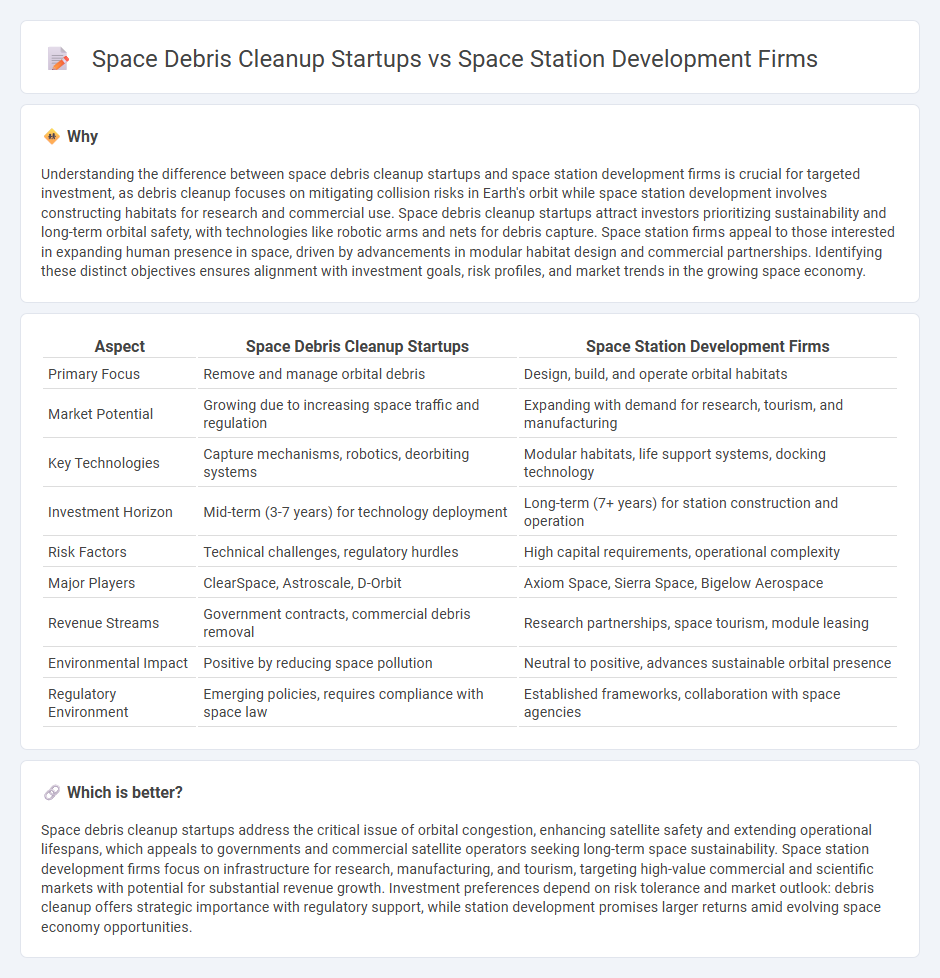
Space debris cleanup startups focus on removing hazardous orbital debris to ensure safer satellite operations and reduce collision risks, leveraging advanced technologies such as robotic arms and net capture systems. Space station development firms concentrate on constructing and maintaining orbiting habitats that support research, tourism, and long-duration missions, driving innovation in modular design and sustainable life support systems. Discover how investing in these pioneering sectors could shape the future of space exploration and commercialization.
Why it is important
Understanding the difference between space debris cleanup startups and space station development firms is crucial for targeted investment, as debris cleanup focuses on mitigating collision risks in Earth's orbit while space station development involves constructing habitats for research and commercial use. Space debris cleanup startups attract investors prioritizing sustainability and long-term orbital safety, with technologies like robotic arms and nets for debris capture. Space station firms appeal to those interested in expanding human presence in space, driven by advancements in modular habitat design and commercial partnerships. Identifying these distinct objectives ensures alignment with investment goals, risk profiles, and market trends in the growing space economy.
Comparison Table
| Aspect | Space Debris Cleanup Startups | Space Station Development Firms |
|---|---|---|
| Primary Focus | Remove and manage orbital debris | Design, build, and operate orbital habitats |
| Market Potential | Growing due to increasing space traffic and regulation | Expanding with demand for research, tourism, and manufacturing |
| Key Technologies | Capture mechanisms, robotics, deorbiting systems | Modular habitats, life support systems, docking technology |
| Investment Horizon | Mid-term (3-7 years) for technology deployment | Long-term (7+ years) for station construction and operation |
| Risk Factors | Technical challenges, regulatory hurdles | High capital requirements, operational complexity |
| Major Players | ClearSpace, Astroscale, D-Orbit | Axiom Space, Sierra Space, Bigelow Aerospace |
| Revenue Streams | Government contracts, commercial debris removal | Research partnerships, space tourism, module leasing |
| Environmental Impact | Positive by reducing space pollution | Neutral to positive, advances sustainable orbital presence |
| Regulatory Environment | Emerging policies, requires compliance with space law | Established frameworks, collaboration with space agencies |
Which is better?
Space debris cleanup startups address the critical issue of orbital congestion, enhancing satellite safety and extending operational lifespans, which appeals to governments and commercial satellite operators seeking long-term space sustainability. Space station development firms focus on infrastructure for research, manufacturing, and tourism, targeting high-value commercial and scientific markets with potential for substantial revenue growth. Investment preferences depend on risk tolerance and market outlook: debris cleanup offers strategic importance with regulatory support, while station development promises larger returns amid evolving space economy opportunities.
Connection
Space debris cleanup startups and space station development firms are interconnected through their shared goals of sustainable space operations and orbital environment management. Space debris removal enhances the safety and longevity of space stations by reducing collision risks, while advanced space stations provide platforms for testing and deploying debris mitigation technologies. Collaborative innovation between these sectors accelerates the development of comprehensive orbital infrastructure and promotes responsible space utilization.
Key Terms
**Space station development firms:**
Space station development firms specialize in designing, building, and maintaining orbital habitats and research platforms, driving advancements in microgravity science and commercial space utilization. These companies leverage cutting-edge technologies to create sustainable environments for long-term human presence in space, supporting scientific experiments, manufacturing, and tourism. Explore how these firms are shaping the future of orbital infrastructure and expanding humanity's reach beyond Earth.
Orbital infrastructure
Space station development firms specialize in constructing and maintaining orbital habitats, leveraging advanced technologies to support long-duration human activities in space. Space debris cleanup startups focus on removing hazardous fragments from Earth's orbit, employing innovative methods like robotic capture and laser ablation to ensure safer operational environments. Explore more about how these sectors collectively enhance orbital infrastructure sustainability and safety.
Commercialization
Space station development firms prioritize long-term commercial opportunities in orbital habitats and manufacturing, targeting sectors like research, tourism, and pharmaceuticals with significant revenue potential. Space debris cleanup startups focus on mitigating orbital congestion to protect valuable infrastructure, offering services critical to sustainable space operations and extending satellite lifespans. Explore how both sectors drive commercialization in space by shaping operational priorities and market growth strategies.
Source and External Links
List of commercial space stations - Wikipedia - Nanoracks is developing the Starlab station with Airbus as a key partner; Vast is creating the Haven-1 and Haven-2 stations, with launches planned for 2026 and 2028 respectively, aiming to replace the ISS eventually.
4 Future space stations projects in the next decade - Orbital Reef is a commercial station project led by Blue Origin, Sierra Space, Boeing, Redwire Space, and others, planned to support 10 people and operational in the late 2020s for commerce, research, and tourism.
Vast - Building Next-Generation Space Stations - Vast focuses on manufacturing its own commercial space stations like Haven-1 and aims to launch humans aboard SpaceX rockets, competing for NASA's Commercial Low Earth Orbit Destinations program.
 dowidth.com
dowidth.com